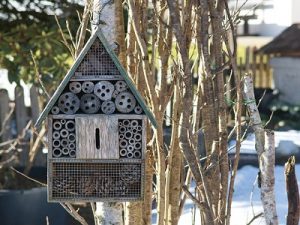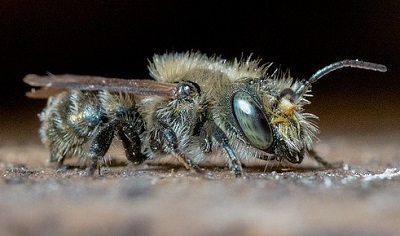Mason bees are important pollinators that build their nests in small cavities, hollow stems, or holes in wood. Unlike honeybees, mason bees are solitary winged insects that spend most of their life flying from flower to flower. It is safe to attract mason bees to your garden as they rarely sting and are incredibly beneficial insects.
 If you are interested in keeping mason bees, then this article is for you. You will find out all you need to know about these effective pollinating insects. If you have fruit trees in your backyard, then you’ll learn why putting up mason bee nests can improve your harvest.
If you are interested in keeping mason bees, then this article is for you. You will find out all you need to know about these effective pollinating insects. If you have fruit trees in your backyard, then you’ll learn why putting up mason bee nests can improve your harvest.
What are Mason Bees?
Mason bees are a solitary bee species in the flying insect genus Osmia and family Megachilidae. The common name mason bee comes from their habit of making nests from mud, clay, or grit to plug nest holes—similar to a mason using mortar. They also construct nests in cracks between bricks, stones, or other masonry structures. Mason bees are related to leaf cutter bees.
There are over 300 species of mason bees, 140 of which are native to North America. The two most common mason bee species are the blueberry bee (Osmia ribifloris) and orchard mason bee (Osmia lingnaria).
Mason bees play a vital role in pollination, especially fruit trees. Fruit tree owners often buy mason bees to pollinate apple trees, pear trees, almond trees, peach trees, and plum trees.
How to Identify a Mason Bee
Mason bees are identified by metallic blue or green bodies and hairy abdomens where they carry pollen. The common orchard mason bee measures about 0.4” (1 cm) long. Like all insect species, the bees have six legs, two sets of wings, and large compound eyes.
You’ll be able to identify mason bees in spring and summer. The bees may look like fuzzy dark flies buzzing around your garden. During these months, the bees are most active. You can spot them crawling into and out of holes in walls, fences, and wooden structures.
What are the Differences Between a Mason Bee and a Honey Bee?

The primary difference between mason bees and honeybees is that they don’t produce honey. Also, mason bees, unlike honeybees, tend to forage for pollen close to the nest. But compared to honeybees, mason bees are more effective pollinators.
These facts make mason bees better than honeybees for pollinating flowering trees and plants.
Mason bees and honeybees also differ in their pollen-collection habits. Honeybees collect pollen and store it in pockets on their hind legs. Mason bees tend to get nectar stuck over their hairy body—a reason why mason bees are the best pollinators among species of bees.
Mason bees are such effective pollinators that it takes 40,000 honeybees to do the work of 400 female mason bees.
Where do Mason Bees Sleep?
Mason bees rest at night and sleep at the entrance to their nest holes. If you have a mason bee nest, you may notice the female’s eyes if you shine a light into unplugged tubes or recesses.
Where Should I Place a Mason Bee House in My Garden

Place a mason bee house on the sunny side of your home about 6 or 7 feet (1.8 – 2.4 m) off the ground. Placing the mason bee box under the eaves will provide some protection from wind and rain.
To ensure mason bees have enough to eat, you should place the mason bee house should be within 300 feet (91 m) of an adequate supply of flowering fruit trees or plants. To make their ‘masonry’ nests, make sure that there is damp earth or mud within 50 feet (15 m) of the nest.
What is the Purpose of Mason Bees?
Mason bees are highly efficient pollinators. It only requires a few females mason bees to pollinate a whole fruit tree. The buzzing, flying insects will also continue ‘working’ in cool or rainy weather. Mason bees are part of a garden’s biodiversity and vital for pollinating flowers.
The sole purpose of male mason bees is to mate with the females.
What is the Life Cycle of a Mason Bee?
A mason bee’s life cycle starts as an egg in the bee nest. The bee hatches a few days after the female lays the egg. The mason larva starts feeding on pollen that the female deposited in the nesting tubes. After ten days, the larva spins a cocoon and overwinters in the nest.
The adult mason bee emerges in spring when the temperature reaches 55°F (13°C).
Mason bee nest tunnels can contain several eggs. Each individual egg is sealed in a separate section of the nesting tube containing enough pollen for the larva to feed and enter the pupal stage.
After emerging from the nest in early spring, female mason bees live for around 30 days and lay one or two eggs a day. They tend to lay eggs in the same nest they emerged from or in a close-by new nest. Males live a shorter time and mate with females.
Are Mason Bees Bad?
Manson bees are beneficial insects that pollinate ornamental flowering shrubs and fruit trees. Although female mason bees have a sting, they rarely sting humans. Even if they do sting people, their bite is barely detectable. Also, mason bees tend to make nests in existing cracks, crevices, and holes in buildings or other structures.
Usually, mason bees are relatively docile insects and are not aggressive. So, if you leave them alone, they are unlikely to bother you.
Do Mason Bees Harm Houses

It’s unlikely that mason bees will cause significant damage to homes. The bees are solitary insects and don’t nest in colonies. They seek out cracks and crevices between stones or in holes in wooden structures caused by other insects.
Left unchecked, mason bee nesting and tunneling activity could cause structural issues—but this is extremely rare.
The females create nesting tunnels and excavate further into softwood material or loose masonry work. These channels could enable water to get into the building, resulting in some weakness or dampness.
Unlike carpenter bees that drill holes and create tunnels, mason bees use existing holes, not make new ones.
If you notice mason bees residing in cracks in your home’s facade, you usually don’t have to do anything. There is no hidden nest or hive to worry about as mason bees are solitary.
Mason Bees — In Conclusion
Putting up a mason bee home is a great way to attract these beneficial pollinators to your garden. Mason bees are not aggressive insects, and they rarely—if ever—sting humans. Additionally, keeping mason bees is an excellent way to enhance your garden’s biodiversity.
